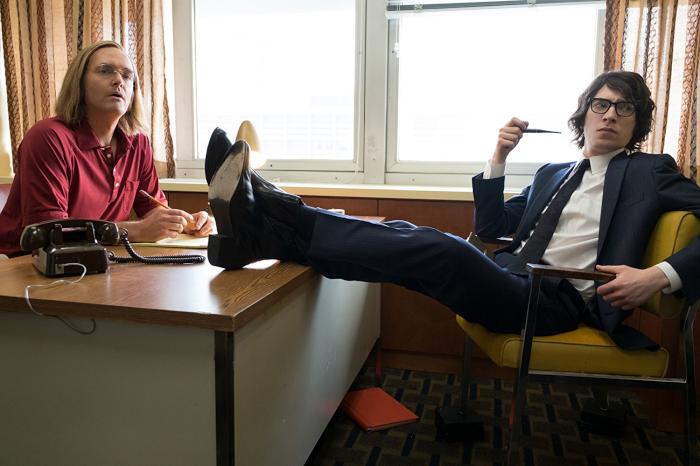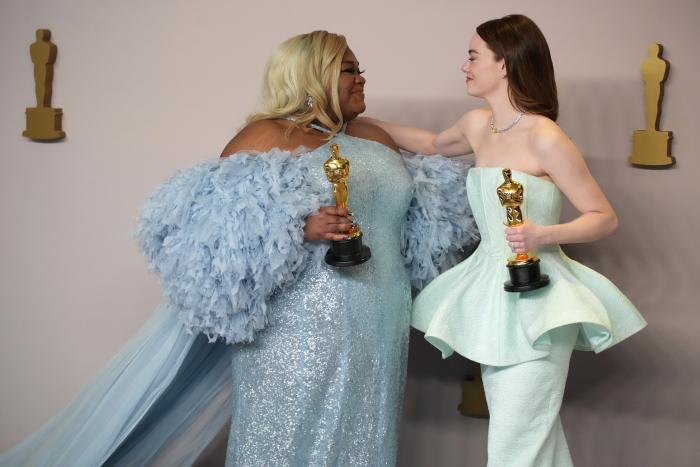

Netflix's 'A Futile And Stupid Gesture' Is A Breezy Biopic Of A Forgotten Man
By Tori Preston | Film | January 29, 2018 |
By Tori Preston | Film | January 29, 2018 |

As a rule, I tend to skip biopics. I’ll watch a documentary about a fascinating person, but dramatizations almost always leave me underwhelmed. The plots are formulaic, the performances feel a little too “LOOK AT ME,” and even if you can buy into the story, a little cursory research usually reveals just how many ugly truths about the real-life person (cheating, domestic violence, etc.) the filmmakers decided to ignore on the way to the big screen. It’s not that I want biopics to be more realistic — no life can be compressed into 2 hours without taking some creative license to move things along. If anything, I want them to take MORE creative license. I want them, I guess, to be David Wain’s A Futile And Stupid Gesture.
The film just premiered at Sundance and launched on Netflix in the same week. It tells the story of a comedy legend you probably don’t remember: Doug Kenney, one of the men who founded National Lampoon magazine and went on to co-write Animal House and Caddyshack. The film follows Kenney, played by Will Forte, from his days at Harvard through his time launching the landmark satire magazine and all the way to Hollywood. Along the way he rubbed elbows with Chevy Chase, Bill Murray, Harold Ramis, Gilda Radner, Christopher Guest, John Belushi — all of whom are featured in the film, and played by actors you may or may not recognize. It’s a ballsy move, portraying comedic geniuses at the start of their careers, people many of us have grown up with, but it pays off — partly because the film directly addresses why none of the actors actually look like their real life counterparts (via a clever narrator in the form of Martin Mull), and partly because none of those characters are really the point of the film. They’re window dressing.
Joel McHale as Chevy Chase arguably has the most to do, and he does it admirably because he has so much experience with the man himself. When asked whether Chase knew about the film in a Vice interview from Sundance, McHale said, “I called him to let him know, ‘David gave me the role, and it’s going forward.’ He was very happy that Doug Kenney, who was his best friend at the time, is finally getting the due that he deserves. As far as me playing him … He kind of laughed, I think.”
But regardless of the big names portrayed in the film, it never loses sight of the fact that it’s still Kenney’s story. And when I say “Kenney’s story” I mean that. This isn’t just the story of his life, this is a story in his style. The film finds strength in trying to do more than be a biopic. It knows that we, the audience, probably don’t remember Doug Kenney — but it also knows that we’ve been influenced by him and his humor anyway. The smartest thing it does is try to tell his story the way he might tell it himself. Leaning into the absurdity of life, even in the more serious moments. Finding inspiration in the pages of National Lampoon and in scenes from Kenney’s movies. It takes a lot of creative license, but it does so with a purpose — and it works.
And here is where I’m going to put a big ‘ol Spoiler Alert because if you don’t know much about Doug Kenney, or the Josh Karp book about him that this film is based on, then certain details of the film should remain a surprise. But they also deserve to be talked about.
As I mentioned, Martin Mull acts as an on-screen narrator, drifting in and out of scenes to comment on them. But he’s not just a narrator — he’s older Doug Kenney, standing by to crack jokes at his younger self’s expense or to point out how little Will Forte looks like him.
“Yeah, so these actors don’t look like the real people. Do you think I looked like Will Forte when I was 27? Do you think Will Forte looks 27?”
Old Doug breaks the fourth wall, effectively thumbing his nose at the seriousness of a “biopic.” Which would be creative license enough, except that the “old Doug” device serves a dual purpose, one that isn’t revealed until the end of the film. You see, Doug Kenney died young. He either fell or jumped off a cliff in Hawaii at the age of 33. If you don’t know who Doug Kenney is, then seeing Old Doug on screen may lull you into thinking that things work out fine for Kenney. In fact, the film ends with his funeral, where Martin Mull and Will Forte (as the newly deceased Kenney) stand together chatting while watching the mourners. And then Forte-as-Kenney decides that everyone is too serious, so he inspires his old partner and National Lampoon co-founder Henry Beard (Domhnall Gleeson) to start a food fight.
No, there wasn’t really a food fight at Kenney’s funeral. But that’s because Kenney didn’t have a chance to write his own funeral. If he had, don’t you think he would have wanted something like that there?
And maybe that’s why I love this biopic. It’s not content just to tell you about this guy’s life. It tries to tell it the way Doug Kenney might have, if he’d had a chance. And in doing so, it pays tribute to the comedy revolution that was the National Lampoon, and all of the figures who came out of that era. It pays tribute to that particular way of looking at the world. It doesn’t shy away from Kenney’s follies — the drug abuse, the ego, the cheating and immaturity and emotional instability — just as it doesn’t sanitize the sexism and privilege inherent in Lampoon. Instead the film shows how those are important parts of the whole story. They’re not something that should be left on the cutting room floor. And the central love story of the film isn’t between Kenney and any woman, but between Kenney and Beard, who acted as the straight man in their two-man act for as long as he could.
The film features a laundry list of actors you’ll recognize, including Matt Walsh, Thomas Lennon, Matt Lucas, Natasha Lyonne, Emmy Rossum, Seth Green, Max Greenfield, and Joe Lo Truglio. And though there are no stand out acting moments, nothing fit for an Oscar reel, the balance the film strikes feels right somehow. The bad wigs, the puns, the breezy pace and the slapdash scene transitions that revel in the film’s artifice — all is as it should be. If you love biopics, this will probably leave you unsatisfied. But if you’re looking for something a little different, give A Futile And Stupid Gesture a chance.
← What Are Those Round Things on the Back of People's Phones? | Dylan O'Brien in 'Maze Runner: The Death Cure' and Teen Dystopia Films →

What’s Old Is New Again: Old Hollywood Glamour Glitters at the 2024 Oscars
Al Pacino Presents Best Picture Oscar, Confuses Everyone
The Dangerous Lie Of 'TradWives'
A Legendary Horror Franchise Is Headed To Television
'The Mandalorian' Season 4 Is Probably Not Happening
Halle Bailey On Why She Chose To Keep Her Pregnancy Private
More Like This
Kyle Mooney's Horror-Comedy 'Y2K' Goes Too Hard on Kyle Mooney's Sense of Humor
'Imaginary' Almost Sucks
Box Office Report: Kung Fu Sandworms
The 2024 Oscars Were Great Right Up Until the End
Kristen Stewart's 'Love Lies Bleeding' Is Gonna Kick Your Ass And Make You Beg For More
Reviews